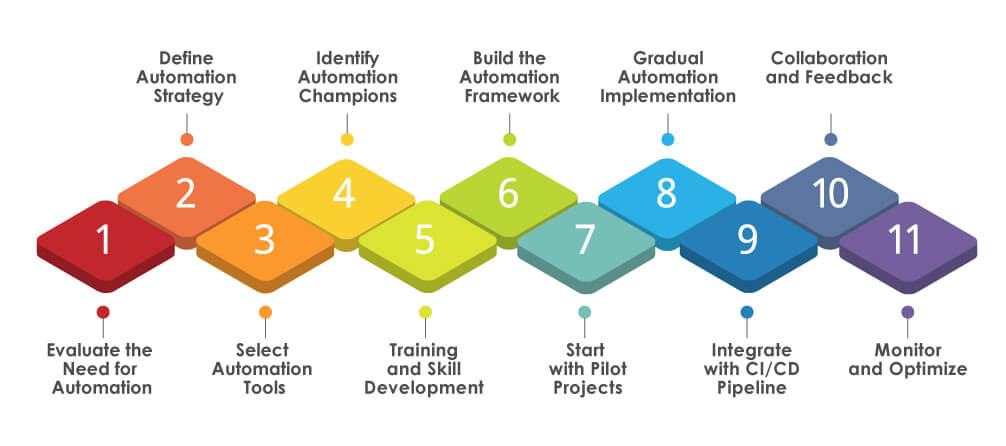Recommended Blogs
How to Transition from Manual Testing to Automation Testing

Testing plays an important role in the software development process, and it is a vital activity that must be completed before the software development life cycle can be considered finished. To ensure the quality of software, a variety of testing tools and elements must be acquired during the accurate SDLC phase.
Every software being developed requires its dedicated group of testers to thoroughly examine its features and functionalities before delivery, as it is common for software to contain bugs or defects. Test engineers take the responsibility of identifying and addressing these defects before the product is released. However, this task is not easy, and even the best manual test engineers using the most effective testing methods may encounter difficulties in completely eradicating these issues.
This is where test automation software comes into play, offering significant benefits to the software testing process. By leveraging test automation, the efficiency, accuracy, and scalability of the software testing process can be greatly improved. This helps in addressing the challenges of manual testing and enables more effective defect detection and resolution. Test automation tools contribute to a more comprehensive and reliable testing process, ultimately enhancing the overall quality of the software being developed.
Why Should you Switch from Manual to Automation Testing?
Switching from manual to automation testing is a strategic move that brings numerous advantages to the software development and testing process.
Firstly, automation significantly enhances efficiency. Automated test scripts can execute a vast number of test cases swiftly, enabling quicker feedback on code changes and accelerating the overall testing process. This speed is especially crucial in today’s fast-paced development environments, where frequent releases are the norm.
Moreover, automation ensures consistency in testing. Unlike manual testers, automated scripts don’t suffer from fatigue, and they perform tests with precision every time, reducing the chances of human error and providing more reliable results. This consistency is essential for rigorous regression testing, where previously validated functionalities need to be rechecked to ensure they haven’t been impacted by recent code changes.
Secondly, automation testing brings cost savings in the long run. Although the initial setup and training may require an investment, the automation of repetitive and time-consuming manual testing tasks leads to reduced labor costs over time. Automation also improves resource allocation, allowing manual testers to focus on exploratory testing, usability testing, and other tasks that require human intuition and creativity, while repetitive, mundane tests are handled by automated scripts.
This redistribution of resources results in more efficient testing processes and, ultimately, cost savings. In a competitive software development landscape, making the switch to automation testing not only ensures faster and more accurate testing but also contributes to improved software quality, reduced time-to-market, and a more cost-effective testing strategy.
Current State of Testing
The software industry seeks professionals proficient in both manual and automation testing. Aspiring test engineers can enhance their skills by undergoing a well-defined Selenium Automation Training program. Various agencies and training bodies offer dedicated testing training to transform individuals into skilled testing professionals. These training schedules often include exposure to various testing tools during Testing Tools Training.
While both manual and automation testing are essential, automation testing holds an edge over manual testing in many test scenarios. Industry giants often prefer automation testing due to its efficiency and scalability. Consequently, the popularity and demand for automation testing have increased significantly in the software industry. As the testing landscape continues to evolve, professionals with expertise in automation testing are in high demand and can advance their careers in the field.
Difference Between Manual Testing and Automation Testing
Below is the comparison of manual testing and automation testing:
Aspect |
Manual Testing |
Automation Testing |
| Execution Speed | Slower, as test cases are executed manually | Faster, as test cases are executed by automation tools |
| Test Case Creation | Manual test cases are created by testers | Test cases are scripted using automation tools |
| Human Involvement | Tester-driven, requires human intervention throughout | Minimal human involvement once automated scripts are set |
| Repetitive Tasks | Tedious for repetitive test cases | Efficient for repetitive test cases |
| Cost | May be costlier due to the need for more human resources | Initial investment required, but cost-effective in time |
| Test Coverage | Subject to human error, may have limited coverage | Offers broader test coverage for various scenarios |
| Maintenance | Test cases need manual updates whenever the application changes | Requires updates when application changes, but easier maintenance |
| Early Bug Detection | Limited ability to detect bugs early in the development process | Facilitates early bug detection through continuous testing in CI/CD pipeline |
| Flexibility | More flexible for ad-hoc and exploratory testing | Limited flexibility for ad-hoc and exploratory testing |
| Skill Requirements | Requires skilled testers to design and execute test cases | Requires testers with automation skills and scripting knowledge |
| User Experience Testing | Well-suited for manual inspection of UI and usability | Less effective in detecting UI/UX issues |
| Regression Testing | Time-consuming for regression testing | Efficient for running regression tests |
| Test Result Analysis | Manual review and analysis of test results | Test results can be automatically analyzed and reported |
| Suitability for All Projects | Suitable for small projects with limited test cases | Suitable for large projects and projects with repetitive tasks |
Transition from Manual to Automation Testing

Switching from manual to automation testing involves a systematic approach and careful planning to ensure a smooth transition. Here are the steps to guide you through the process:
Evaluate the Need for Automation:
Begin by assessing your testing requirements and determining which test cases are suitable for automation. Focus on repetitive, time-consuming, and critical test scenarios that can benefit from automation. Consider the project size, complexity, and expected ROI to prioritize test cases for automation.
Define Automation Strategy:
Create a detailed automation strategy that outlines the goals, objectives, scope, and timeline of the automation process. Identify the automation tools and frameworks that best fit your project requirements and budget.
Select Automation Tools:
Research and select appropriate automation testing tools that align with your project’s technology stack and support the type of testing you need (e.g., UI testing, API testing, performance testing). Popular automation tools include Selenium, Appium, TestComplete, and JUnit.
Identify Automation Champions:
Appoint experienced testers or automation specialists as automation champions who will lead the transition from manual to automated testing. These individuals will be responsible for creating automation test scripts, setting up the automation framework, and mentoring other team members.
Training and Skill Development:
Provide training and skill development opportunities to your testing team to ensure they have the necessary expertise to work with the selected automation tools. This may involve workshops, online courses, or on-the-job training.
Build the Automation Framework:
Develop a robust automation framework that will serve as the foundation for your automation testing efforts. The framework should include guidelines for test script development, reporting, error handling, and data management.
Start with Pilot Projects:
Begin with small, low-risk pilot projects to validate the automation framework and test scripts. This allows your team to gain hands-on experience and identify any potential challenges or areas for improvement.
Gradual Automation Implementation:
Gradually expand automation coverage by automating additional test cases and scenarios. Continuously monitor and review the results to ensure accuracy and reliability.
Integrate with CI/CD Pipeline:
Integrate automation testing with your Continuous Integration/Continuous Delivery (CI/CD) pipeline to enable automated testing of new code changes and ensure continuous feedback on software quality.
Collaboration and Feedback:
Encourage collaboration between manual and automation testers to share knowledge and insights. Regularly collect feedback from team members to identify areas for improvement and address any challenges that arise during the transition.
Monitor and Optimize:
Continuously monitor the automation process, track test metrics, and optimize test scripts for better efficiency and maintainability. Regularly review the automation strategy to align with evolving project requirements.
By following these steps and embracing automation as an iterative process, you can successfully transition from manual to automation testing services, improving testing efficiency, accuracy, and overall software quality in your projects.
Conclusion
Test automation offers numerous benefits to software testing teams, particularly for those transitioning from manual to automated testing. With test automation, testers can focus more on handling edge cases, product managers can meet their deadlines more effectively, and clients can receive a polished and high-quality final product. For testers accustomed to manual testing, the advantages of test automation are significant.
How Can TestingXperts help you Switch from Manual to Automation Testing?
TestingXperts can be your trusted partner on the path to transitioning from manual testing to automation testing. With their expertise and proven track record, we provide comprehensive solutions and support throughout your journey. Our skilled trainers offer top-notch training programs, equip you with the essential skills in automation tools and scripting languages. Whether you’re a novice or an experienced tester, their tailored training caters to your specific needs, ensuring a smooth transition. TestingXperts’ hands-on approach and real-world scenarios prepare you for practical challenges in automation testing. With our regular consultation, you can make the shift to automation testing seamlessly, unlocking new career opportunities and enhancing your testing capabilities. Wish to know more? Let’s connect!
Discover more
Stay Updated
Subscribe for more info
